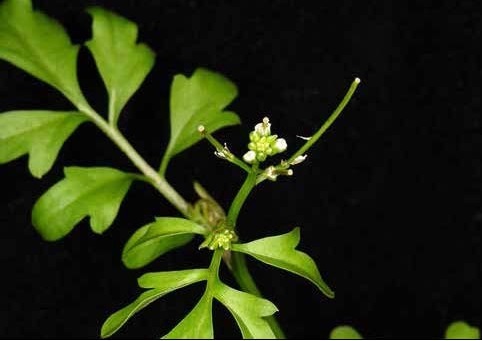What is that battalion of tiny white flowers appearing all over the lawn so early in the season? The one with the lacy green doily at the base, and sword-like seed pods, and the maroon cast? Gasp! It is the hairy bittercress!!! Now before you call out the weed police or haul out the weed killer, consider this: Did you know that hairy bittercress is a very important early source of pollen and nectar for bumblebees? As such it should be conserved along with (double gasp!!) dandelions.
Now that we have that out of the way, let’s settle down to learn a bit about hairy bittercress habits and some do’s and don’ts for dealing with an outbreak of it. This weed grows best in damp, recently disturbed soil. Be wary of digging it up in spring because this practice opens holes for crabgrass to emerge. A winter or summer annual, different varieties of bittercress have different heights. A key characteristic is its basal rosette, a “doily” like circular array of leaves at the bottom of the plant. The weed will germinate in fall or winter but grows best during warm weather. It quickly invades thin turf especially where there is good soil moisture. Shade encourages its growth, and it may escape mowing by low growth. Post-emergence control for it generally includes using 2, 3, or 4-way herbicide; treatment during its basal rosette stage is best before it throws up a flower stalk and begins to produce seed.
Hairy bittercress thrives in sandy, organic soil. Wash your nursery containers rather than leaving them around with soil clinging to them—dirty containers harbor its seed, with six times more seedlings emerging from dirty containers than from those that are rinsed. Also, containers lying around tend to breed Asian tiger mosquitoes! Now you have two good reasons to clean up your containers.
Hairy bittercress has exploding seed pods but little germination of fresh seed. Instead, its seed ripens with high temperatures. The higher the temperature, the greater the temperature range at which subsequent growth will take place. Hairy bittercress can germinate from April through November; however, autumn is its main period of emergence. Peak flush of germination is in November and December, but this varies from year to year. We don’t notice these plants until spring when they throw up flowers and seedheads, seeming to mock us from our winter-bound vantage points as we eyeball our winter weary lawns. Just remember: Each hairy bittercress you allow to flower helps support our vital pollinators when they really need the nectar and pollen these plants provide. So help out a bumblebee, and leave hairy bittercress alone if you can; it’s an annual so it’s gonna die anyway….
Dr. Tamson Yeh is CCE Suffolk Turf Use and Land Management Specialist. She can be reached at tsy3@cornell.edu or 631-727-7850 x240.

